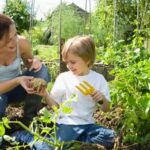Are you looking for a fun and educational activity for your four-year-olds? In this article, we will explore the world of vegetable gardening and how to introduce this fantastic hobby to young children. We will discuss the benefits of teaching vegetable gardening at a young age, as well as how to select the right vegetables for four-year-olds.
Additionally, we will provide tips on creating a fun and engaging lesson plan, hands-on activities, and maintaining their interest in gardening. By the end of this article, you will have everything you need to kick-start a vegetable gardening lesson plan for four-year-olds.
When it comes to introducing young children to vegetable gardening, there are countless benefits that go beyond just learning about plants. From developing fine motor skills to fostering a love for nature and healthy eating habits, teaching four-year-olds about vegetable gardening can have a profound impact on their development. Not only will they learn practical skills such as planting and watering, but they will also gain valuable knowledge about where food comes from and the importance of sustainability.
One of the first steps in creating a successful vegetable gardening lesson plan for four-year-olds is selecting the right vegetables. It’s important to choose options that are easy to grow and maintain while also capturing the attention and curiosity of young children. Carrots, cherry tomatoes, and snap peas are just a few examples of vegetables that are perfect for little gardeners due to their quick growth and vibrant colors that appeal to young eyes.
Benefits of Teaching Vegetable Gardening at a Young Age
Teaching vegetable gardening to four-year-olds has numerous benefits that extend beyond the classroom or home garden. This section will explore the positive impact of introducing young children to gardening at such a formative age.
Early Exposure to Healthy Eating
Introducing children to vegetable gardening at a young age helps them develop an early appreciation for healthy foods. By actively participating in the process of planting, cultivating, and harvesting vegetables, four-year-olds are more likely to show interest in consuming fresh produce. This hands-on experience can pave the way for a lifetime of healthy eating habits, setting a strong foundation for their physical well-being.
Developing Responsibility and Patience
As young children engage in caring for their own vegetable garden, they learn valuable life skills such as responsibility and patience. Monitoring the growth of plants, watering them regularly, and waiting for vegetables to mature teaches four-year-olds important lessons about nurturing living things. These experiences help instill a sense of responsibility and foster patience-a virtue that is crucial for their overall development.
Connection With Nature
Encouraging four-year-olds to engage in vegetable gardening provides them with an opportunity to connect with nature firsthand. Through this interactive learning experience, children gain a deeper understanding of the natural world around them. They become more attuned to seasonal changes, biodiversity, and the interconnectedness of living organisms. This connection with nature fosters an appreciation for the environment and instills a sense of stewardship from an early age.
Selecting the Right Vegetables for Four Year Olds
When selecting vegetables for a gardening lesson plan for four year olds, it is important to choose vegetables that are easy to grow and maintain. This will ensure that the young children have a positive experience with gardening and see tangible results from their efforts. Here are some excellent vegetable options that are suitable for four year olds:
- Carrots: Carrots are a great choice as they are easy to plant and take care of. They also have the added benefit of being a familiar and popular vegetable amongst young children.
- Tomatoes: Tomatoes can be exciting for four year olds to grow because they can see them ripen and change color. Cherry tomatoes are particularly fun as they can be plucked directly from the vine and eaten.
- Radishes: Radishes have a fast growing cycle, which is perfect for holding the attention of four year olds. They can see the results of their efforts in just a few weeks.
In addition to choosing the right vegetables, it is important to involve the children in the selection process. Allow them to participate in picking out seeds or seedlings at the garden center or nursery. This will help them feel invested in the project and excited about caring for their chosen vegetables.
Furthermore, it’s also crucial to consider the space available for planting. If working with limited space, compact plants like lettuce or spinach might be more appropriate. By involving the children in this process, they will learn valuable lessons about decision-making and responsibility while having fun with vegetable gardening.
Ultimately, by carefully selecting suitable vegetables for four year olds, educators and parents can ensure that the children have an enjoyable and successful experience with their vegetable gardening lesson plan.
Tools and Materials Needed for a Vegetable Gardening Lesson Plan
When creating a vegetable gardening lesson plan for four year olds, it is essential to have the right tools and materials on hand to ensure a successful and engaging experience for the young learners. One of the most important tools needed for the lesson plan is child-sized gardening equipment such as small trowels, rakes, gloves, and watering cans.
These tools are not only safe for four year olds to use, but they also allow them to actively participate in the gardening process.
In addition to child-sized gardening equipment, it is important to have appropriate materials for planting and growing vegetables. This includes soil, seeds or seedlings, pots or planters, and fertilizer. It is crucial to choose non-toxic and child-friendly options when selecting these materials to ensure the safety of the young gardeners. Providing colorful and visually appealing pots can also add an element of fun and excitement to the gardening experience for four year olds.
Furthermore, having educational resources such as age-appropriate books about vegetable gardening, pictorial guides of different vegetables, and interactive materials like flashcards or posters can enhance the learning experience for four year olds. These materials can help introduce them to various types of vegetables, teach them about different stages of plant growth, and provide visual reinforcement of key concepts related to vegetable gardening.
By having these tools and materials available, educators can facilitate a hands-on and enjoyable vegetable gardening lesson plan for four year olds.
Creating a Fun and Engaging Lesson Plan for Four Year Olds
When creating a fun and engaging lesson plan for teaching vegetable gardening to four year olds, it is important to take into consideration their attention span and need for hands-on activities. By incorporating interactive and exciting elements into the lesson plan, you can ensure that the young learners are enthusiastic about learning and participating in the gardening experience.
Interactive Storytelling and Planting Activity
One way to make the lesson plan fun is by integrating interactive storytelling with a planting activity. You can start by reading a children’s book about gardening or growing vegetables to capture their interest.
After the story, engage the children in planting seeds of easy-to-grow vegetables in small pots or garden beds. This hands-on activity not only teaches them about the process of planting but also instills a sense of responsibility as they care for their own plants.
Sensory Exploration Garden
Another exciting element to include in the lesson plan is a sensory exploration garden. Set up different stations where four year olds can explore various textures, scents, and tastes related to different vegetables.
For example, have a station with soft soil for them to dig their fingers into, another with aromatic herbs like mint or basil for them to smell, and a tasting station with fresh vegetables such as carrot sticks or green beans. This multi-sensory experience will not only teach them about different vegetables but also cultivate their curiosity and love for nature.
Garden Art and Craft Activities
Incorporating art and craft activities into the lesson plan can further enhance the fun factor of learning about vegetable gardening. Provide materials for children to create garden-themed artwork such as vegetable stamp painting, making scarecrows out of paper bags, or crafting DIY plant markers for their garden. These creative activities help reinforce what they have learned while allowing them to express themselves through art.
By including these interactive and engaging elements in your vegetable gardening lesson plan for four year olds, you can make learning about gardening both educational and enjoyable for young minds. This approach not only helps foster a love for nature but also lays the foundation for lifelong appreciation of gardening and healthy eating habits.
Hands-on Activities for Teaching Four Year Olds About Vegetable Gardening
When it comes to teaching four year olds about vegetable gardening, hands-on activities are crucial for making the learning experience fun and engaging. One of the most effective activities is to have the children plant their own seeds in small pots. This not only teaches them about the planting process but also gives them a sense of ownership and responsibility as they watch their plants grow.
Another great hands-on activity is to take the children on a garden scavenger hunt. Create a list of items commonly found in a vegetable garden, such as tomatoes, lettuce, or flowers. Then, let the kids explore the garden and check off each item as they find it. This activity not only familiarizes them with different vegetables and plants but also gets them moving and active outdoors.
Lastly, consider having a tasting activity where the children get to sample different vegetables from the garden. Let them taste freshly picked carrots, snap peas, or cherry tomatoes. This not only introduces them to new flavors but also shows them the end result of their gardening efforts.
| Variety | Description |
|---|---|
| Cherry Tomatoes | Small, sweet tomatoes that are perfect for little hands. |
| Snap Peas | Crunchy and delicious pods that are easy for kids to eat. |
| Rainbow Carrots | Colorful carrots that come in shades of purple, orange, yellow, and white. |
By incorporating these hands-on activities into your vegetable gardening lesson plan for four year olds, you can make learning about gardening an enjoyable and memorable experience for young children.
Tips for Maintaining the Interest of Four Year Olds in Gardening
Engaging four year olds in vegetable gardening can be a fun and rewarding experience, but it’s important to maintain their interest throughout the process. Here are some tips to keep your young gardeners engaged and excited about their vegetable gardening lesson plan:
1. Keep it Simple: Four year olds have short attention spans, so it’s important to keep the gardening activities simple and straightforward. Choose vegetables that are easy to grow and maintain, such as cherry tomatoes, radishes, or lettuce.
2. Make it Fun: Incorporate games and activities into the lesson plan to make gardening more enjoyable for the children. For example, you can create a “treasure hunt” for different plant parts like leaves, roots, and fruits. You can also have them decorate their own plant markers with colorful stickers or paint.
3. Offer Rewards: Encourage participation by offering small rewards for completing tasks or reaching milestones in the garden. This could be as simple as giving out stickers or allowing them to sample vegetables they’ve grown themselves.
4. Provide Hands-on Experiences: Allow the children to get their hands dirty and explore the garden through sensory experiences. Let them plant seeds, water the plants, and harvest the veggies themselves. This hands-on approach will help maintain their interest and excitement throughout the gardening lesson.
By incorporating these tips into your vegetable gardening lesson plan for four year olds, you can help ensure that they stay engaged and enthusiastic about learning how to grow their own food. With patience and creativity, you can create a positive experience that will instill a love of gardening in these young learners for years to come.
Conclusion and Additional Resources for Vegetable Gardening Lesson Plans for Four Year Olds
In conclusion, teaching four year olds about vegetable gardening can be a rewarding and valuable experience for both the children and their caregivers. Through hands-on activities and engaging lesson plans, young children can learn about the natural world, develop important life skills, and cultivate a love for healthy eating habits from an early age.
It is essential to select the right vegetables that are suitable for four year olds, taking into consideration their developmental abilities and interests. Providing the necessary tools and materials, such as child-sized shovels, watering cans, and kid-friendly gloves, will make the gardening experience more accessible and enjoyable for young learners.
Maintaining the interest of four year olds in gardening requires creativity and patience. Incorporating fun activities like creating garden markers or holding a harvest celebration can keep the children engaged and excited about their growing plants.
Additionally, seeking out additional resources such as children’s gardening books or local gardening groups can provide further support and inspiration for vegetable gardening lesson plans for four year olds. Ultimately, introducing young children to the joys of vegetable gardening can instill a lifelong love for nature and healthy living.
Frequently Asked Questions
How Do You Teach Gardening to Elementary Students?
Teaching gardening to elementary students involves hands-on activities such as planting seeds, watering plants, and observing growth. It also includes teaching them about different types of plants, basic gardening tools, and the importance of sunlight and water.
What Are the Learning Objectives of Gardening?
The learning objectives of gardening include teaching students about plant life cycles, the role of soil and nutrients in plant growth, and the environmental benefits of gardening. It also aims to develop their fine motor skills, patience, responsibility, and appreciation for nature.
What Do Plants Need to Grow Lesson Plan Preschool?
A preschool lesson plan on what plants need to grow typically focuses on teaching children about the basic needs of plants: sunlight, water, air, and nutrients. This can be done through interactive activities like planting seeds, creating a mini indoor garden, or going on a nature walk to observe different types of plants in their natural environment.

If you’re looking to get into vegetable gardening, or are just looking for some tips on how to make your current garden better, then you’ve come to the right place! My name is Ethel and I have been gardening for years. In this blog, I’m going to share with you some of my best tips on how to create a successful vegetable garden.





